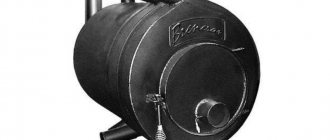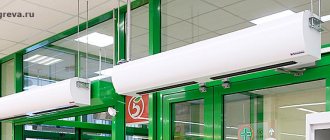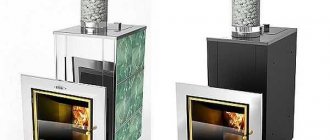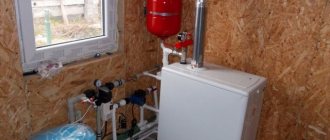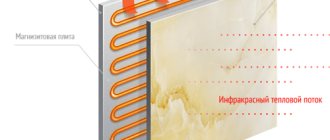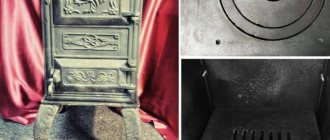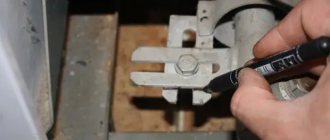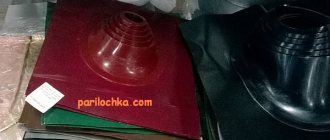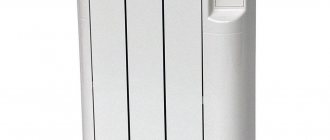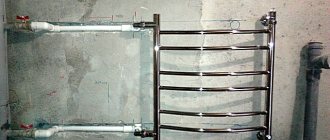Oil radiators are an excellent option for economical heating of a room. They are actively used in apartments, private homes, offices and warehouses all over the world. A good heater can provide up to 99 percent energy efficiency because almost all the electricity consumed is converted into heat, and this is one of its main advantages.
Today there is a wide range of heating equipment, in the labyrinths of which it is not difficult for an inexperienced buyer to get lost, so today we have presented the most complete answer to the question: how to choose an oil heater for the home. We'll also talk about what you need to know before you buy and see what the experts have to say. So, let's go!
Operating principle of an oil cooler
The principle of heating using an oil-type radiator is quite simple. Powered by electricity, it uses current to circulate thermal oil, which in turn heats up. Passing along the edges of the device, the oil emits heat.
As the temperature around the radiator rises, hot air rises, circulating heat and distributing it throughout the room. This process can be slow, but because there are no fans or heating coils, an oil cooler uses less energy than an electric-type unit. In addition, it is silent, which is also important.
Types of oil-filled heaters
There are several types of oil radiators:
- Floor-standing. They are installed on the floor on special legs. Most often they have wheels to make it convenient to move the device within the room. Floor heaters are the most popular type of device for the home. Is it possible to store an oil cooler lying down? Yes, you can. But it cannot be used in this position.
- Wall-mounted. Special fastenings allow you to hang the heater on the wall. This is the most suitable option for unheated offices - such a battery is difficult to move, it is best to fix it in one place.
- Skirting. Such devices have small compact sections, but their number is increased compared to standard models to make it convenient to place the heater along the wall.
- Fireplace type. These models have additional holes to speed up air circulation. This is necessary for spacious rooms where good convection is important so that it is fully heated.
Exploitation
Using an oil heating device is not difficult. You just need to plug it into the outlet, wait 10-15 minutes and enjoy the warmth throughout the entire room.
But there are some rules that must be followed to avoid trouble:
- Do not cover the radiator with cloth or other material, especially when it comes to slots in the device. Of course, if necessary, you can dry some things on it, the main thing is that they do not cover the entire device. If the slots are closed for a long time, the device may overheat and the oil may boil.
Oil boiling is the main problem with radiators of this type, because, in addition to damage to the device itself, there is a possibility of hot oil splashing into the room, which can lead to both burns of people in it and a fire. Therefore, be careful about the condition of the device before using it.
- Radiators are made from an alloy of metals that are usually susceptible to corrosion. Therefore, avoid frequent contact with liquid on the surface of the device. If corrosion eats through the metal surface of the radiator, hot oil may leak.
- You should only use mineral oil of the type specified in the instructions for your device. If you fill in the wrong oil, damage to the device is inevitable.
- It is unacceptable to mix different types of oils. Each liquid contains its own set of additives, and contact of different types of liquids when heated can lead to bad consequences.
- Do not use the device after the expiration date specified in the instructions for it, or if its individual elements are damaged.
How not to use an oil heater
Like any electrical appliance, before turning it on, an oil radiator must be installed as far as possible from any source of water - accordingly, it cannot be installed in a bathroom.
During operation, its surfaces become very hot, so you should not touch them with an unprotected hand. As already mentioned, the minimum distance between the operating device and any object in the room must be no less than 500 mm, otherwise the heater will heat itself with reflected heat and the emergency temperature sensor will turn off the device. To avoid overheating, it is strictly forbidden to cover the surface of a working heater with anything, no matter dry or wet things. If you pay attention to the removable towel rail that comes with some models of oil radiators, then the things placed on it will not dry close to the device - not at some distance. By the way, the process of drying things on a heated towel rail (and only on it!) should be strictly monitored by household members - after the things have dried, they must be removed from the hanger.
Pros and cons of oil heaters
Like any equipment, oil heaters have their advantages and disadvantages. Let's take a closer look at each point in order to make the right choice.
Minimum fire hazard level
The oil heater does not have any exposed heating panels or coils. This reduces the chance of the heater setting things on fire. Some models also have an automatic power-off feature that kicks in whenever the heater tips over or reaches maximum temperatures.
Expert opinion
Filimonov Sergey Vinokurovich
Heating equipment repairman
Automation avoids overheating. In this sense, this type of heating device is superior to electric and even gas equipment, the level of fire hazard of which is much higher.
Heat distribution throughout the room
The principle of most electric heaters, in particular the heating gun, is to direct the hot flow in one direction. Of course, over time, the room heats up, but if the room is large, or there are cracks or open doors, then this heat will quickly evaporate. Another thing is the oil heater. It distributes warm air currents throughout the room, which lasts for a long time.
Energy efficiency
An oil radiator is considered an economical type of heating. First, by converting current into heat, it consumes very little energy. Secondly, due to the large heating surface, the device allows you to heat large rooms. And finally, thirdly, unlike other types of heating devices, such as ceramic heaters, the oil-filled version does not cool down quickly when turned off.
This ensures that it still distributes heat for some time after it is turned off, allowing for further energy savings.
Can be used with thermostat
An oil-filled heater can be coupled to a thermostat to make it more energy efficient. When the room reaches the optimal temperature, the thermostat allows the heater to enter sleep mode, which saves energy until the temperature drops below the set level.
Silence
Energy efficient and quiet, oil-type units do not dry out the air like electric models do. All these factors make this option an excellent choice for creating warmth and comfort in your home.
And now it's time to talk about the disadvantages. Experts cite the following disadvantages:
- Long heating process . The design of the device does not provide rapid heating; it will take up to 15 minutes before the device becomes hot. It also takes at least 15-20 minutes for it to cool down.
- Slow heat circulation . Compared to other types, oil-fired units do not have fans, and therefore it takes at least 20-30 minutes to circulate heat throughout the room.
- Devices used for large rooms tend to be bulky . In terms of size, they are inferior to electric ones. But, if you need to heat one room, you can choose a small radiator that will not take up much space in the room and weighs no more than 5-6 kg.
- If we talk about older models (which are rarely seen in stores), they could freeze during long-term storage at low temperatures. But new models have improved in this matter, and the problem has been solved.
Expert opinion
Filimonov Sergey Vinokurovich
Heating equipment repairman
The advantages of an oil-filled heater outweigh the disadvantages. This gives it advantages over other types of heating devices, making owning an oil-filled heater necessary, especially in the cold season.
Design and principle of operation
The design of this device is as simple as possible. There is a sealed metal shell containing mineral type transformer oil (hence the name). Another mandatory element is the heating element.
There is also a power cord with plug and a control unit.
Additionally, almost all units are equipped with wheels for easy transportation, since the object itself is quite heavy.
There is often a protective cover that prevents contact with the hot surface. This is especially appropriate in families with small children. In some cases there is a clothes dryer.
To achieve optimal indoor humidity levels, some products include a humidifier. Water is poured into it, which gradually evaporates and saturates the air with moisture. But it is still advisable to use a separate humidifier.
The operating principle of the device is as follows: after connecting to the network and setting the mode, the heating element begins to heat up and heat the oil. Gradually it heats up and gives off its heat to the body, which transmits it into space.
The advantages of such solutions include:
- noiselessness;
- safety – the case does not heat above 60 degrees;
- long service life - the elements hardly wear out, and such a device can operate continuously for up to three days;
- do not affect the environment - that is, they do not dry out the air and do not burn dust.
But there are also features that need to be taken into account if you are choosing which is better: a fan heater, infrared or oil heater.
The mechanism of action explains the main drawback of the equipment: long warm-up. From other devices, for example, convectors, heat begins to be felt immediately. But the oil object requires at least 20 minutes to prepare. But after it “heats up,” the product will give off heat even after being disconnected from the network.
This technique also cannot ensure rapid distribution of heat throughout the room. To correct this feature, models with fans are produced. They force air to circulate more intensely throughout the room and provide uniform heating. Although you will have to put up with noise during operation.
Now it is fashionable to mention the possibility of creating a “fireplace effect”. It is formed due to the special structure of the radiator, namely the presence of thermal slots. They create draft, and this is how air masses mix. Otherwise, there is a great risk that all the heat will concentrate under the ceiling, and the floor will still be cold.
Types of oil radiators
There is a distinction between oil-type heating devices into two categories:
Oil-filled device
This is a typical portable heater that people use in most cases, usually to heat a private house or apartment. The radiator consists of oil-filled pipes or coils through which heated oil flows by convection. This creates heat on the coils, which is radiated into the room to ensure the most comfortable room temperature possible.
Oil furnace
This is the central unit that provides heat to your entire home. The main unit is usually located in the basement or other storage area in the home. Here the oil is mixed with air and burned. The flame heats a metal heat exchanger, which then mixes with air, forcing heat through your home's interior ductwork to be delivered throughout your home.
Features of the design of oil heaters
We have described the structure of the oil heater, now let’s discuss the details. Firstly, an air cushion, eliminating the possibility of the radiator rupturing. Oil has a temperature coefficient of expansion that must be compensated for. The air cushion is not the only step in the right direction. The effect of a musical accordion is used - the bellows take in air and release it, changing the volume. When pressure arises inside, the body simply becomes a little longer, which is difficult to notice with the naked eye; quiet grinding sounds can be detected by ear.
This is interesting! The air cushion partially compensates for temperature deformations. This option extends the service life and reduces the requirements for the strength of seams.
The oil heater is non-separable, do not try to open the housing. When holes appear, microwelding is the best method. Soldering is not a solution; the operating temperature of electronic devices does not even reach 150 ºС. Thermal fuses of Elenberg DVD player transformers are designed for 135 ºС.
Main characteristics of modern oil radiators
Experts highlight the following technical characteristics that distinguish modern oil radiators from other types of heating devices.
Safety shutdown
When choosing a portable oil heater, make sure it has safety shut-off features to minimize the risk of fire. Options should include overheat protection and rollover protection. Some models also offer freeze protection to ensure the oil doesn't freeze if it gets too cold when stored in freezing temperatures for long periods of time.
Manufacturer's warranty
Be sure to look for an oil heater that is backed by a solid warranty from a reputable company. There are many heater manufacturers and sellers out there, and not all heaters are designed to be super reliable and long lasting. You don't want to invest in a new heater only to have it break shortly after purchase and find that you have no way to replace it.
Incremental thermostat
While all oil heaters come with adjustable thermostats, those with gradual changes are the most customizable, allowing you to increase or decrease the heater's temperature by one degree. Some oil heaters offer very limited temperature settings, making it difficult to achieve the desired level of heat in a room.
Multiple heat settings
A good oil heater will allow you to customize the amount of heat produced depending on your needs or comfort level. Look for a heater that offers at least two or three heat settings ranging from low to high.
Other Considerations
Heat capacity
Consider the size of the space in which you will be using the oil heater. Large rooms require 900 to 1,500 watts of heating power, while small offices, bathrooms and bedrooms can be adequately heated with a 300 to 500 watt heater. If you are going to heat a small room, then a larger and more expensive heater is not necessary.
Mobility
If you plan to use your oil heater in different areas of your home or office, ease of portability is key. Some oil heaters are bulky and much heavier than other models. Does the device have wheels for easy transportation?
Which is better
Before purchasing a radiator, you should calculate how much area it will need to heat. The heating function depends on the power of the radiator and the number of sections.
The power is selected depending on the size of the room in which the radiator will operate: for 10 square meters of room you need 1 kW of generated electricity.
The formula applies to rooms where the ceiling height is no more than 2.75 m. If the ceilings are located higher, the required power can be calculated using the following algorithm:
- Multiply the length of the room by the width to get the area.
- Multiply the resulting number by the height of the room, this way you will get the required volume.
- Divide the resulting figure by 25, because 1 kW of energy per 25 m3 is calculated. The result obtained is the power needed to heat the room.
Then it’s a matter of individual taste and financial capabilities. A simple oil heater has a standard set of functions and is inexpensive.
Models equipped with fans, timers, humidifiers and remote controls are more expensive, but more comfortable to use.
Top brands
At the moment, you can see a huge number of oil devices on the market, but the most popular and modern among all brands are the following.
The Honeywell company was founded back in 1906 by engineer Mark Honeywell. Honeywell was a pioneer in the home plumbing and heating industry and is still known for producing high-quality products such as the Honeywell 7-Day Programmable Thermostat and portable air conditioners.
Founded in 1902, the company is a renowned manufacturer of small household appliances based in Treviso, Italy. Its espresso machines and coffee makers are among the best in the industry, as is its large line of portable heaters.
Pelonis has been in the portable heating and cooling industry for over 25 years. Based in Exton, Pennsylvania, the company manufactures a reliable line of portable air conditioners, fans and radiators in a variety of styles.
It's a compact appliance manufacturer that was started over 15 years ago by Luke Peters, who sold portable air conditioners and other home appliances out of his garage. Today, the company has diversified significantly to offer all types of small household appliances to suit every taste.
Prices for oil heaters
- 1600-2000 RUR: This price range will give you a limited selection of portable oil heaters. Very tiny and compact models that are suitable for heating small spaces, or models without many additional features, tend to be in this price range.
- 2500-4000 RUR: This price range offers many options for oil heaters. Here you will find additional options such as programmable timers, remote controls and digital displays.
- Over RUB 4,500: Here you will get access to the most futuristic, sleek oil heater designs that will come equipped with all the modern features such as incremental digital temperature control, energy-saving operating modes and much more.
Advantages and disadvantages
Modern manufacturers offer the following types of devices for additional heating:
However, an oil heater is considered the best device.
This popularity is due to numerous advantages:
Oil radiators quickly warm up the air in rooms, provided that the power of the device corresponds to the area of the room recommended for heating. Cost-effectiveness is due to low energy consumption, fast heating and slow cooling of the heating element. Hot oil continues to give off heat even after the device is turned off.
The disadvantages include the following:
The case temperature is high, so be careful not to touch the heater while it is on. To avoid accidental burns, especially if there are small children in the house, it is recommended to use a protective cover. If the radiator power is incorrectly selected, a lot of electricity is consumed.
As you can see, there are many more advantages than disadvantages. Manufacturers recommend choosing an oil heater for your home, apartment or cottage.
Choosing the best oil cooler. Top 5
From a wide range of models, experts highlight the following:
Timberk TOR 21.1809 SLX
Timberk TOR 21.1809 SLX
This unit's three heat modes and five temperature settings maximize efficiency and control, while the programmable thermostat ensures ease of use. Price 2700-3400 rub.
Pros:
- Design fits into a variety of home decors
- Has several safety precautions and an automatic shut-off timer
Minuses:
- The heater and timer only operate at the specified temperature and time settings
- Not as customizable as some other models
Termatic 1500 W
Termatic 1500 W
For a fraction of the cost of other heaters on the market, you can get 1500 watts of power that could heat a medium to large room. It is equipped with several safety features to prevent accidental fires. Price 3600-4000 rub.
Pros:
- Compact and unobtrusive design, ideal to fit into any interior
- It works so quietly that you can forget that it is even there
Minuses:
- The design of the faceplate and casting wheels does not feel as durable as some other models
TESY 2009
TESY 2009
This radiator is a good option for home and office use due to its portable design. The small size allows this device to easily fit under a desk or next to a wall. Price 6500-7000 rub.
Pros:
- The adjustable thermostat is a nice feature that allows you to customize your comfort level. Despite its compact design, it heats up quite quickly and efficiently while keeping energy costs low. While this heater may not be the best solution for heating large spaces, it effectively heats a 40-square-foot area and is great for smaller spaces or for use in conjunction with central heating.
- It operates very quietly, allowing you to talk on the phone or watch TV without distractions.
Minuses:
- It would be nice if this heater was more visually appealing, but if you're going to keep it in a designated area rather than in the middle of the room, its design won't really matter.
De'Longhi Oil Filled Heater
This oil heater features comfort temp technology that reduces energy costs and automatically maintains a comfortable temperature in any room you place it in. Heating parameters vary from 700 to 1500 W. The price varies from 7,000 to 76,000 rubles.
Pros:
- Aesthetic design automatically maintains optimal temperature and power settings
- Comes pre-assembled for use straight out of the box
Minuses:
- Can collect dust and can be a bit of a labor-intensive process to clean
- Takes up space when not in use
TESY CC 3012 E05 R
TESY CC 3012 E05 R
Electric oil heater TESY CC 3012 E05 R is an excellent choice of heat for rooms of almost any size. It is equipped with twelve sections that provide 3000 W of heat. Price 7900-8500 rub.
Pros:
- Its easy-to-use thermostat dial allows you to gradually control the unit's temperature.
- This heater provides quiet, radiant heat that won't dry out your skin like other types of air heaters or irritate you with noisy operation. Like many other models, it comes with overheating and tip-over protection that turns off the heater as soon as it detects a problem.
Minuses:
- The only thing this heater lacks is a programmable timer that allows you to turn off the unit while you are sleeping or away from home. Otherwise, we like the simple design and durability of this oil heater.
How does an oil heater work?
The pros and cons of oil heaters have been discussed many times. The undoubted conclusion is that it is the best choice for small privateers. An oil heater is called an oil heater because it contains oil inside the tank, a working medium that simultaneously satisfies a number of criteria:
- Oil has a low coefficient of thermal expansion. For example, for water heaters this is a difficulty. When a fence is made from the riser, a cycle of temperature rise begins, the liquid expands at different speeds. Water's thermal expansion coefficient is many times higher than that of steel. The surface of the tank is often covered with enamel, which has temperature characteristics similar to metal. This makes the device durable, otherwise, if the paint layer becomes cracked, corrosion will begin and the tank will leak. To avoid such difficulties, water is not poured into the oil heater. When boiling, steam would form and rupture the tank.
- The entire world of heating technology is concerned about electrochemical corrosion, when two metals are placed in water (with salt solutions), as a result, current begins to flow between the electrodes. The first piece is restored, the second is destroyed. For obvious reasons, copper rivets are prohibited in aviation. Otherwise, the wing planes and the fuselage surface will begin to collapse. Aluminum is considered a donor; if the heating element is made of copper, the steel accordion body will feel the damage. As a result, the oil will leak onto the floor the next time you turn it on. If a liquid was poured inside, allowing a current of charge carriers to pass through, electrochemical corrosion would become the scourge of heaters. This doesn't happen.
- Security is closely related to the previous property. The heating element represents a tube into which the powder is pressed. There is a spiral in the heart that allows current to pass through and gives heat. If the tube is pierced, the powder gets wet and crumbles, resulting in potential on the body. A short circuit depends on the nature of the damage and does not always occur. Therefore, in an aquatic environment there would be a possibility of electric shock if the device is not properly grounded. In the case of an oil heater, the chance is less. However, the grounding terminal should not be left hanging in the air; place the eyelet on the neutral wire of the phase. Then, when potential appears on the housing, a short circuit will occur. As a result, the heating element or the fuse on the electrical panel will burn out.
- Oil boils at a higher temperature (olive oil - 150 degrees Celsius) than water. Therefore, the radiator is heated above 100 ºС, performance will not be lost. The upper limit of operation is determined by a thermal fuse mounted on the inside of the housing in the area of the heating element. An element is needed in case the device's thermostat fails. Unlike water heaters, in this case the sensor is not installed on the surface of the heating element. A bimetallic plate is located in the electronic unit and controls the air temperature. If it jams, the settings will be lost, the thermal fuse will save the situation. Thus, the operating principle of an oil heater is fundamentally different from a water heater. Remember if you need to replace the heating element.
Inside the tank, in addition to oil, one-eighth of the container contains atmospheric air.
It's a matter of oxidation. The oil will start to burn if you turn the oil heater upside down and turn it on, the heating element will be in an aggressive oxygen environment. First, carbon deposits will appear, then the heating element will begin to fail. The operating temperature will increase, later the process will increase, and the oil will begin to burn out. For this reason, some devices are equipped with fall sensors. A fire is impossible, the temperature of the oil heater is not so high, a thermal fuse will protect against overheating. The latter stands on the body near the heating element to protect the device if the oil leaks out or the radiator falls and the heater tube ends up in the air.
How does an oil heater work? The heating element consists of two spirals that work separately or together. The exit to emergency mode is controlled by a thermal fuse. The thermostat is built on the basis of a bimetallic plate, like in a household iron. Turning the knob changes the tension, hence the response temperature is different. The bimetallic plate does not touch the body, this is different from the iron. Usually located on the electronics casing, mounted on the side of the radiator. Air passes through the slots from the floor to the ceiling of the compartment, bypassing the sensor. It triggers at the right moment. We believe that the casing heats up due to conduction, but the temperature is lower than the oil. You can easily verify this with your own hand by touch when the device is turned on.
Features of oil heaters - the mode does not directly depend on the temperature of the coil. We see the difference from the iron, where the bimetallic plate is attached to the soleplate next to the thermal fuse. Sensors cannot be replaced directly. So:
- The device turns on.
- Goes into mode.
- It is switched off at the right time by a bimetallic strip.
- It's cooling down.
- Turns on again.
Therefore, the sensor is not attached to the body. The accordion changes temperature too quickly (despite its impressive volume). As a result, the relay will operate more often, and the operating life in hours would decrease. There would be no way to control the air temperature. In order for the radiator to deliver power, it must have a fixed temperature difference between the room atmosphere and the surface. We think that the control method chosen by the manufacturers looks more effective, and in addition, it is convenient to display the adjustments on the front panel.
As a result, the operating principle of an oil heater comes down to the natural circulation of oil inside the radiator.
Expert advice
- Always turn off your oil heater when leaving the house to minimize the risk of fire.
- If you have small children, be sure to place your oil heater in a space that minimizes the risk of accidental knocking over or changing temperature settings by prying hands.
- Be sure to keep the heater in a well-ventilated area away from curtains, furniture, or clutter to avoid accidental overheating or burning.
- Always read online reviews before purchasing to see what other consumers have experienced with the specific model you are interested in.
GENERAL RESULTS
The overall assessment consisted of three indicators: functional tests (50%), assessment of technical parameters (30%) and assessment of ergonomics and ease of use (20%).
It's nice that all models received "good" ratings.
The best in terms of ergonomics was the De'Longhi TRD0820ER heater, the leader in technical parameters was the Aeronik PO-1123M, and the winner in the functional tests was the Vitek VT-1729 BK heater.
We also note the most economical (in temperature maintenance mode) oil heater among the tested models - Beko BRZ-2009.
Questions and answers
HOW EFFECTIVE ARE OIL HEATERS?
Portable oil heaters are nearly twice as efficient as their forced air ceramic counterparts.
WHAT IS THE CHEAPEST TYPE OF OIL HEATER TO BUY?
As a rule, the smaller the cheaper. It is cheaper to purchase heaters with lower efficiency, which are better suited for small spaces.
WHAT IS THE BEST OIL FILLED HEATER?
The best oil-filled heater is one that has automatic safety shut-off features, multiple heat settings, and a solid manufacturer's warranty.
DO OIL HEATERS USE A LOT OF ELECTRICITY?
Oil radiators generate more energy than other types of portable heating units. A typical 1500-watt oil heater running for six or seven hours a day will add less than RUB 100 worth of electricity. per day, compared to a typical ceramic air heater, which will generate electricity per day of more than 250 rubles, with the same operating mode. Therefore, oil radiators are among the most economical heating devices.
Conclusions and useful video on the topic
In this video, buyers' attention is drawn to those purchase parameters that we did not consider in this article in order to avoid duplication of information. It will help you avoid mistakes and get what you need.
It doesn't matter whether you buy one of our recommended oil heater models or choose something else. If you have read this article, then you know how to choose and what criteria you should follow to understand which oil heater is best for you. So, guided by these criteria and common sense, you will make the right choice.
Tell us about how you selected an oil heater for your cottage/office/apartment. Share what was the decisive factor when making a purchase. Please write comments in the block below, post photos related to the topic of the article, and ask questions about points of interest.
